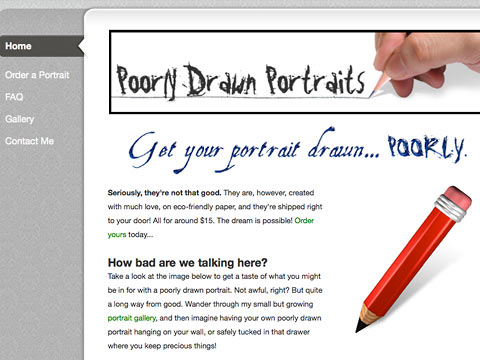DECEMBER 1, 2009
It's the webby thing to do
In Web Publishing I class we often talk about how "webby" a site is and what makes it so. "Webby" refers to anything about the site that is unique to the web, something cannot be duplicated in other media (print, film, video, etc).
Using this standard, basic interactivity—click here to go there—is not really webby. That type of interaction has been around for years via software like (then) Macromedia Director, Flash and a host of other programs. Probably the earliest product that made this available to ordinary folks was Apple's HyperCard, first released in 1987. One of the earliest blockbuster computer games, Myst, was created with HyperCard. Very interactive, not on the Web.
By the same token, animation and recorded live motion are not webby, since they've been around in the film world for years. Ditto sound. Combined sound, animation and motion used to be called multimedia, and again was around before the Web became popular.
So none of these features often seen in websites are truly webby. What is?
Links
At the very core of the Web is its ability to connect people with information using links, the more the merrier. In 1991, Tim Berners-Lee, considered the father of the World Wide Web, described a new hypertext environment: "The WorldWideWeb (WWW) project aims to allow links to be made to any information anywhere."
One of the most exciting (and sometimes frustrating) aspects of the Web is how you start out looking for one thing and end up exploring something totally different simply by following a chain of links. Any website that doesn't liberally link to other sites is not webby.
Feedback
From simple email links to sophisticated social networking sites like Facebook, feedback is a huge part of webbiness. Older media types have no built in feedback mechanism. You have to send a letter to a film's director to share your thoughts with him/her. You can only do this outside of the film viewing experience itself. They are two separate things.
On the other hand, every website has (or should have) an email link that allows you to instantly send comments to the site's creator. More significantly, many sites—especially blogs and social networking sites—make it easy to add your comments where they will be seen by everyone.
Customization
By design, your viewing experience of the Web should be customizable using the Preferences setting of your browser. The idea is that you can make the type bigger or smaller, change the typeface, and pick colors to suit yourself. At the most basic level you can make the window you use to view a website larger or smaller.
Diabolically clever web designers have learned how to keep you from doing that by specifying these things with style sheets, locking them inside of images or Flash interfaces, and/or making fixed-size sites. Not webby.
But a thoughtful web designer can allow (encourage?) at least some customization by creating alternative style sheets and/or by building a site that is "flexible," adjusting to how large you make your browser window.
Quirkiness
Hard to define, but you know it when you see it. And you see it a lot on the Web. Personal obsessions not only are welcome, they thrive in its atmosphere. Squished pennies, notes found on the street, and Toothpaste World are perfectly comfortable on the Web. In fact I'd argue that they are the poster children of webbiness. If you want to see more examples, visit the Museum of Online Museums. (Go ahead, I dare you. Just kiss your To-Do list goodbye.)
 This entire article was prompted by a link to Poorly Drawn Portraits that I saw at Design Observer.
This entire article was prompted by a link to Poorly Drawn Portraits that I saw at Design Observer.
Poorly Drawn Portraits is the sort of unique personal idea/business that could never even pay the rent at a little kiosk in the mall, but might survive—or thrive—on the World Wide Web.
There's an economic theory called the Long Tail that explains how with a large enough pool of potential buyers even the most specialized product can be profitable. The Web provides a huge pool of potential buyers.
So a poorly drawn portrait is very webby. How can you resist the puppy dog sincerity of this:
Seriously, they're not that good. They are, however, created with much love, on eco-friendly paper, and they're shipped right to your door! All for around $15... How bad are we talking here? Take a look at the image below to get a taste of what you might be in for with a poorly drawn portrait. Not awful, right? But quite a long way from good.
What else is webby?
I've told you what I think makes a site webby. Now it's your turn. What exactly do you look for in a website that cannot be accomplished in other media like print, film or video? Use the Comment link below to add to the list.
It's the webby thing to do.
Top |
|
![]()
